7 Major Game Design Changes from the Nintendo 64 Era
The old is becoming fashionable again. Just look, for example, at Playtonic Games' Yooka-Laylee game: a nostalgic 3D platformer in the style of Banjo-Kazooie and Donkey Kong 64 . Playtonic was ready for this project - many team members used to work at Rare, which created the classics of the 1990s.
With the help of Yooka-Laylee , the Platonic team is trying to show how a classic-style 3D platformer can look like in a modern gaming market. After a successful campaign on Kickstarter, the Yooka-Laylee will be released in April of this year.
Needless to say, a lot has changed in the games since Nintendo 64. We asked Playtonic employees to tell us about how technological improvements have influenced various areas of game development, and what they meant to designers, artists, composers and directors involved in the development process.
1) Ready engines simplify work

')
Previously, developers had to create their own tools for each game. With the advent of ready-made engines, the need for this has disappeared.
“The big difference is that in the era of the N64, most of the gaming tools we had to write by hand for each project. Today, there are not only Unity-type engines, but they are also platforms themselves that allow the community to develop their own tools on top of the engine, ”said Chris Sutherland, project manager for Yooka-Laylee (he was the lead programmer for Banjo-Kazooie ) .
This approach is good for detecting errors, and for increasing team productivity.
“On N64, most of the errors had to be corrected by development engineers. Today, thanks to such diverse, stable and easy-to-use toolboxes, it is not necessary to understand the code to correct errors, ”says Sutherland. “This also applies to the final stages of product preparation, in which not only programming is necessary. Because of this, you can more effectively use the staff of the development team. ”
2) Artists must restrain themselves

Sometimes unlimited imagination itself can be a problem. Yooka-Laylee technical art director Mark Stevenson (he used to be Donkey Kong 64 art director), shared his thoughts on how technological advances force artists to limit themselves, rather than relying on the technical limitations of the equipment.
“The difference lies mainly in much more powerful equipment and significantly improved tools and technologies,” says Stevenson. While all of this is good for extending capabilities and optimizing performance and workflows, there are also advantages to such advantages. It is necessary to constantly restrain oneself and make reasonable decisions in order to achieve the necessary results and a high level of quality, without losing control over the situation.
“In the days of the N64, we always tried to use the equipment to the maximum and push the boundaries of what is possible for very weak technologies,” says Stevenson. “Today it is easy to feel like a child in a pastry shop and start breaking into serious things, therefore, having a team of such dimensions as Playtonic’s, one should always clearly understand the boundaries. But the difference lies in the fact that these boundaries must be set by oneself, and not rely on the limitations of technology. ”
3) Characters become alive
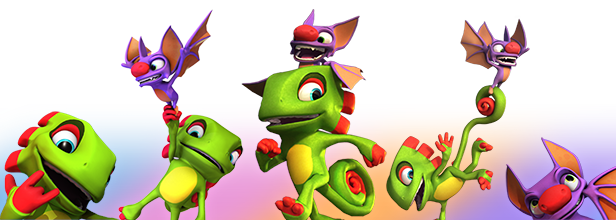
Let's look at the character design in Banjo-Kazooie . Especially on the Banjo. Remember the big bear with a blue backpack and moving fingers?
Your memories are fooling you. There was nothing like this on the Nintendo 64. Details and character animations are another area in which games have taken a big step since Banjo began his journey.
"Today, we are capable of much more in animation," says Steve Mayles, art director for Yooka-Laylee characters (he was a Banjo-Kazooie character artist). “We had to work with the minimum number of connections on the N64 - each additional connection reduced performance. Therefore, the poor old Banjo did not even turn his eyes, his mouth did not move or even his fingers! ”
“Now we can create any number of connections. Due to time constraints, sometimes some connections are not even animated, but you can use them if necessary, ”says Meyls. "The way of binding the geometry to the skeleton allows us to create a much more realistic animation compared to the solid vertices with which we worked on the N64."
But it also means that technology gives artists the opportunity to work on details that the player may not even notice, and which will become a waste of time.
“For characters, we can create animation layers today (for example, while running, they can bend over), but still we always need to evaluate whether to add certain details. Will people notice them, or do we do it for our own pleasure? Sometimes you just need to draw a line and move on to the next task. ”
4) Size matters
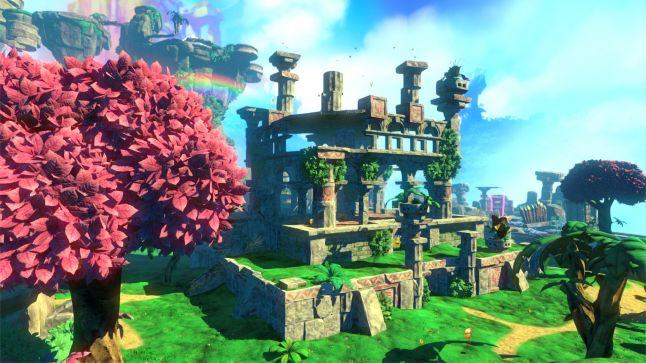
Not everything technological progress simplifies the work. The 3D landscapes and reliefs that players travel through are becoming increasingly large. This means that you need more and more hands to create them and breathe life into them.
“Creating environments has become much more difficult,” says Yooka-Laylee’s art director for environments, Steven Hurst (former Banjo-Kazooie environmental artist). “Although the tools of creativity have become much more functional, and models are easier to create, the detail and size of the worlds have increased significantly. Therefore, production time has become much longer than before, and more people are needed for it. ”
Development for several platforms also has its problems. Unlike the Banjo games, which were intended only for the N64, the Yooka-Laylee will be released on different consoles.
“When creating a multiplatform game, resources should be more scalable. We need to pay more attention to aspects such as different levels of detail (Level of Detail) to ensure smooth operation of the game on various equipment. Development for one platform is simpler, because we knew its limitations and capabilities, ”says Hurst.
5) More polygons - more headaches.
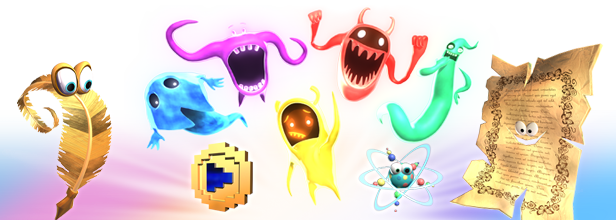
Whatever the development of gaming technology, human capabilities are limited. He can not change the number of hours per day or increase the amount of work performed during the week. And some processes, such as character development, require more time today than needed decades ago.
"The development of the concept, model and animations for the character on the N64 took a week (if you worked as hard as I did)," says Steve Meyls. “We worked with approximately 500 polygons, and now we use ten thousand. Of course, the tools have become better, but even in the programs of 1997, work on 500 polygons was faster than today - on ten thousand. Now you can lay on the same process for about a month, and you are not much mistaken in the estimates. "
Due to a much longer time frame, less time is left for mistakes, backtracking or changing directions.
"It is becoming more and more important to ensure proper character development from the very beginning of development," admits Males. “We have a relatively small team, and the last thing we need is to redo our work. To “get on the right path”, you need, if necessary, to use a lot of people and ask yourself the following question: “Does he match the style of the game?” “Does he fulfill all design requirements?” And so on. Sometimes the appearance of the character leads to new ideas in design, so this work goes both ways. ”
6) Details vs. design
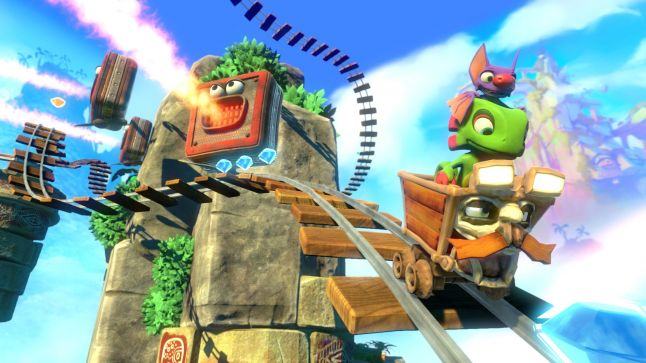
The more 3D worlds, the more places you can visit and make routes. But it also means that there are more areas in which the player can get lost.
“When planning and designing worlds in 3D, it is much easier to reach the sensations of space, to find a way and create points that are important for the plot,” says leading creative specialist Gavin Price (previously designer Grabbed by the Ghoulies ). “However, creating a design language for the player’s unobtrusive orientation at the level and focusing his attention has become much more difficult.”
Today, designers cannot simply rely on technical constraints and should help players understand which parts of the level are important.
“The power of modern systems can be used to fill and decorate the world with detailed details. Everything suddenly starts to look interesting and important. The player can blindly move around the surroundings, not moving along the game plot. As a result, he has a feeling of dissatisfaction, ”says Price. “In many ways, the limitations of the old systems simplified the life of a level designer, because only important parts of the world had interesting details.”
7) The secret is in sound
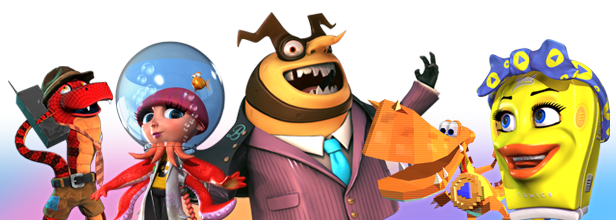
Although the process of composing music has not changed much, Grant Kirkhope, the composer of Yooka-Laylee (formerly the composer of Banjo-Kazooie ), tells how an increase in memory allowed him to add better music to Yooka-Laylee.
“My workflow for writing music has hardly changed,” says Kirkhope. “I'm still sitting at the keyboard and trying to record the music that I like. However, the quality level of this music has changed significantly. ”
Previously, a big problem was the amount of memory used. Composers had to cut music to fit inside the N64 cartridge.
“In those days of the N64 era, I had to use samples of the instruments, reduce their quality, but keep the music acceptable, then compress them, and only then add to my tiny MIDI set that was in the N64 cartridge,” Kirkhope recalls. “I was given a limited amount of memory for everything, including sound effects. It seems that for Banjo-Kazooie it was 2 megabits! ”
And despite the fact that restrictions still exist, music in games has taken a big step forward.
“Today I can use libraries of super-quality samples that sound so authentic that they are sometimes difficult to distinguish from real sounds,” says Kirkhope. “Memory limits us much less than before. The limits are still there, but they are no match for the past. Obviously, the sound should fit on the disc, it is compressed and the full CD quality cannot be achieved, but the difference with the sounds for Banjo-Kazooie or GoldenEye is enormous! ”
Source: https://habr.com/ru/post/326494/
All Articles